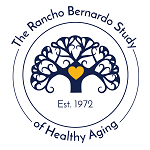The Rancho Bernardo Study (RBS) of Healthy Aging is a community-based study, now in its 47th year (as of 2019). The RBS was established between 1972 and 1974 when 82% of adult residents (aged 30-79 years) of Rancho Bernardo, a suburb of San Diego, California, were enrolled. Because Rancho Bernardo was marketed as a retirement community, participants had moved from all parts of the US, and half were age 60 and older. Most were married, of Northern European ancestry, and middle to upper middle class. Since then, follow-up examinations have been conducted at approximate 4-year intervals. More than 450 studies based on the RBS cohort have been published to date, many with doctoral and post-doctoral students as first author.
The RBS is one of the longest, continuously funded, NIH observational cohorts in existence. It has focused on cardiovascular disease since its inception in 1972, on diabetes since 1984, on cognitive function since 1988, and on bone disease since 1990. The rich RBS dataset is unique in the detailed and repeated measurement of risk factors and outcomes related to these diseases, and the long period of follow-up for clinical events. Annual follow-up for vital status is conducted by mail or phone, with death certificates obtained for decedents and cause of death classified by a certified nosologist. Every other year participants are mailed a checklist of chronic diseases and surgeries, modifiable lifestyle factors (diet, cigarette smoking, alcohol intake, and physical activity), and health-related quality of life. Since 1984, RBS participants have returned for 8 research clinic visits designed to measure subclinical and clinical cardiovascular disease, diabetes, cognitive function and bone health, among other outcomes. Participants from the original cohort were eligible for these visits if they were at least 45 years of age (for most visits), were ambulatory, community-dwelling and able to provide informed consent. Each visit included a detailed medical history; measurements of blood pressure, lipids, glucose and physical function; administration of a battery of cognitive function tests; and evaluation of body composition and bone mineral density by dual-energy absorptiometry (DXA).
The Archive
Archiving of the Rancho Bernardo Study of Healthy Aging (RBS) began in 2016 with funding by a grant from the National Institute of Aging (grant AG054067). The overarching goal is to curate, document and electronically archive as much of the RBS database dating back to 1972, as possible, to immortalize and share the data. By making the RBS database available on a freely accessible website, our hope is that current and future researchers will continue to use these data for secondary analyses, combining them with other large cohort studies for big-data approaches, and maximizing NIH’s long investment in the RBS, as well as informing public health.
Visit Data Curation: Data collected at RBS research clinic visits has been aggregated into meaningful categories across 12 visits spanning 44 years. Variable codes and formats have been harmonized across visits. A unique and valuable feature of the RBS archive is the creation of longitudinal datasets across all research visits for most data groups, facilitating life-course approaches.
Visit Data Description: Each data group has a separate page accessed via a drop down menu under the Visit Data tab. A link to the data dictionary is provided at the top of each data group page, followed by an overall description of the data group and a summary table of the topics included in the data set. Detailed information is provided on methods used in collecting the data, along with pertinent references. The amount of methods detail provided is commensurate with the complexity and variability of the data acquisition procedures.
Annual Mailer Data: A wealth of information on a wide-variety of topics was collected from 32 annual mailers beginning in 1977. The most recent mailer was in 2017; mailer data collection is on-going. Mailer data are provided as cross-sectional data sets for each individual mailer. Variable names are not harmonized. See the Annual Mailer tab for additional information. Data for all mailers will be available in May, 2020.
Data Access: RBS data are openly available for download (via the Data Access tab), after reviewing and agreeing to the terms and conditions described in the Data Use Agreement.
Slideshow: To view a slideshow providing a general overview of the Rancho Bernardo Study and archive, click on this link: Presented at the 2019 Gerontological Society of America Annual Meeting.
